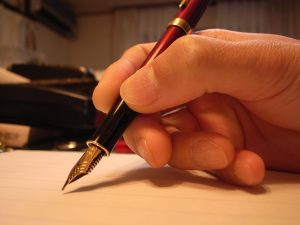Researchers in the social sciences, which includes library and information science, use the American Psychological Association (APA) Publication Manual (7th ed.) to guide the formatting of their papers and publications. The APA Manual is what we’ll be using in this class, and in most of your other MLIS courses. What follows are some of APA 7 style’s most important rules for formatting a paper’s text and references.
See also:
Things to Use: APA 7 Style:
Rules for the Body of the Paper:
Formatting the Text:
- 1-inch margins on all sides
- San serif fonts such as Calibri or Arial in 11-point OR Lucida Sans Unicode in 10-point
- Serif fonts such as Times New Roman in 12-point OR Georgia in 11-point OR Computer Modern in 10-point
- Indent paragraphs 5-7 spaces or ½ inch
- Double space the paper throughout, even block quotes and the reference list
- Put only one space after the period ending a sentence
- Page numbers should appear in the top right-hand corner
- Note: APA 7th Edition no longer requires a running head for student papers, only include page numbers, beginning on the title page
Ordering of Contents:
- Title Page: Centered in the upper-half of the page, using upper and lower case letters type the following lines: the title in boldface, author’s name, institutional affiliation, course number and name, instructor name, and assignment due date. In APA 7, the title page is page 1, which should be included on this page.
- Abstract: A one-paragraph summary of the paper’s content. The abstract should be descriptive and not exceed 250 words. It is placed on page 2, with the title Abstract, in boldface and centered at the top of the page.
- Begin your paper’s text on page 3.
- The reference list comes after the text. Begin the list on a new page and use the heading References in boldface and centered at the top of the page.
Capitalization:
- Capitalize all major words in the titles of books and articles mentioned in text. Note: This is at variance with the format used in the reference list.
- Capitalize minor words like prepositions and conjunctions only if they are 4 letters or more in length.
Italics and Quotation Marks:
- Italicize the titles of books, journals, magazines, newspapers, musical works, websites, films, and TV shows.
- Put quotation marks around article titles, chapter titles, short stories, poems, and individual web pages. Note: This is at variance with the format used in the reference list.
Quotations:
- Incorporate short quotations into the text and enclose them within double quotation marks. Use single quotation marks for a quote within a quote only.
- If the quotation is more than 40 words in length, make it a block quotation, which do not require quotation marks. The entire quote should be indented 5 spaces from the left-hand margin to separate it from the body of the main text and should be double spaced.
- If more than 2 paragraphs are quoted, indent the first line of each paragraph an additional 5 spaces.
- Use 3 dots or ellipses [. . .] to indicate that words appearing in the original quotation have been omitted. If the omitted material comes at the end of a sentence, use 4 dots . . . .
- If an editorial mistake was made in the original text, add the word [sic] in brackets following the error.
Numbers:
- Use figures for numbers over 10, and spell out numbers below 10
- Use figures for all numbers that precede a measurement (5 feet)
- Use figures for all numbers that represent time, dates, ages, or number of subjects (50 years old; 7 adult men)
- Use figures with % (5%)
Citing Authors in the Text:
When you use the words or ideas of another person in the body of your paper, you must provide a reference to the original source. APA 7 does not use footnotes and a bibliography. Instead, APA 7 uses what’s known as the “author/date method.” With this method, you provide the name of the author and the date of publication in parentheses immediately after the material you are quoting or referring to. At the end of your paper, you provide a reference list that gives the full bibliographic information for the items cited in your text.
So how do you do this? There are 2 basic methods.
- When the author’s name is mentioned in the text, put the date in parentheses after the name, like this: Vann (1961) traces the development of library training methods and assesses their strengths and weaknesses.
- When the author’s name is not mentioned in the text, put both the author’s name and the publication date in parentheses at the end of the sentence before the period: The influence of Melvil Dewey on the development of library education has been a topic of much study (Vann, 1961). If the author and date are given in the text, no parenthetical reference is needed.
Providing in-text references for quotations is a bit more complicated:
- When quoting an author whose name is mentioned in the text, put the publication date in parentheses after the author’s last name and the page number for the quote at the end of the sentence.
- Note that the page number is placed after the quote marks but before the period: As Hart (1996) argues, “Blah, blah, blah” (p.109).
- If the quoted author is not mentioned in the text, then include the author’s name in the parenthetical reference at the end of the sentence: (Hart, 1996, p. 109).
- With a block quote, the parenthetical reference goes after the final period, which is different from the rule cited above.
APA 7 also has an elaborate set of rules governing the content and punctuation used in the parenthetical references. Here are the most important rules:
- Put a comma between the name, date, and page number: (Vann, 1961, p. 12).
- If a source has 2 authors, put an “&” between their last names: (Wells & Davis, 2000).
- If an author has 2 publications in the same year, indicate a and b after the year (1999a) to differentiate them.
- If 2 or more sources are cited in the same reference, put the authors’ last names in alphabetical order and separate them with a semicolon: (Davis, 2000; Hart, 1999; Wilson, 2008).
- When citing an entire website, rather than a document on a website, simply list the website’s URL in parentheses after the website’s name: Kidspsych (http://www.kidspsych.org) is an interactive website for children.
- When you mention a publication that has no identifiable author, list the first few words of the title in the reference. These title words should be capitalized
The Reference List:
The reference list is where you will give full bibliographic information for all of the sources listed in parentheses in the text. Remember, you should include in the reference list only items that are mentioned in text. This is different from other style manuals that allow you to list publications items you consulted as well as those you cited in the paper. Also, only include “recoverable” sources in the reference list (not emails, conversations, interviews, or class lectures) even though these may be cited in your paper.
General Formatting:
- Put the reference list at the end of your paper and call it References, in boldface, and centered.
- The reference list is double-spaced, with a hanging indent. Hanging indent means that the first line is at the left-hand margin and subsequent lines are indented 5 spaces. This highlights authors’ names.
- Arrange the references in alphabetical order by author’s last name. If there is no author, alphabetize the item by title.
More Links and Resources for APA 7 to Explore:
- APA Style Blog https://apastyle.apa.org/blog/
- Villagran, M. (2020). APA 7th- Bias-free language guidelines summary: APA 7th – Bias-Free Language Guidelines Summary
- “The seventh edition of the APA Manual endorses the use of ‘they’ as a singular pronoun. The manual advises writers to use “they” for a person whose gender is unknown or irrelevant”: See OWL at Purdue Changes in the 7th Edition for more information on Writing Style and Grammar, and Bias-Free Language integrated into the new edition.
- Villagran, M. (2020). APA 7th- Tables, figures and images summary: APA 7th- Tables, Figures and Images Summary
- APA Style resource: https://apastyle.apa.org/

